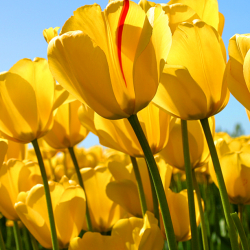| 1.Приветствие. Организационный момент.
2. Воспроизведение и коррекция опорных знаний учащихся.
3.Определение темы и цели урока. Мотивация учебной деятельности учащихся.
4. Первичное закрепление в знакомой ситуации. Активизация навыков ознакомительного, поискового, изучающего чтения.
5.Физкультминутка- элемент здоровье развивающей технологии
6. Творческое применение и добывание знаний в новой ситуации (проблемные задания). Развитие навыков строить связное монологическое высказывание с вербальной опорой (краткое описание товара).
7.Рефлексия, домашнее задание и выставление оценок.
8. Заключительный этап урока. | 1. Good morning, my dear friends! You may take your seats! I am very pleased to see you today! How are you today? Oh, I am glad for you. What lesson did you have before? Did you have good marks? 2. Today you will work in groups. To start our lesson I want you to look at the screen. You can see the word “CLOTHES”, please write as many words related to this topic as you can. Good, read them, please. 3. I’m sure you know that all clothes is made of different fabrics, for example do you know what this is made of? And this…? Could you tell me what we are going to speak about at today’s lesson? Yes, you are right but we shall to speak about unusual clothes ECO CLOTHES. What do you know about eco clothes? Please, think of three questions what else you would like to know about eco-clothes, and write them on the papers. Please read your questions.
4. Now, open your books on p.70, we shall read the text and try to answer your questions. While reading you should complete the gaps with words derived from the words in brackets, then we shall listen and check. Good for you. So, did the text answer your questions? Let’s discuss. OK, can you imagine that these mittens are made of this (plastic bottle). Please look at the screen, I’ll show an interesting video (https://youtu.be/tTFNBIdgRPg 2.14 min.). SingText is fabric made of coffee grounds. What are advantages of SingText? Why do they call SingText environmentally friendly fabric?
5. Are you tired? Let’s have a rest. Shall we do some exercises?
6. Do you feel better now? Ok! Good for you! It’s time for another task. Next task for you will be a project. In groups, using information from the text, prepare a leaflet to encourage your classmates, me and our guest to buy eco-friendly clothes. You may write or draw something or read the information, but remember you MUST BE convincing. You’ll have 10 min. Then one of you will present your project to the class.
7. To sum up our discussion about eco-clothes, I want to thank you for your participation. Do you enjoy our lesson today? What did you like most at today’s lesson? Tell me please what can you do now? (screen) Your work was excellent during the lesson, so all of you will get excellent marks today. Your home assignment is to do task in your student’s books page 72.
8. The lesson is over. See you tomorrow. | Приветствуют учителя. Отвечают на вопросы.
На экране написано слово «Одежда», учащиеся должны вспомнить как можно больше слов по данной теме.
Учащиеся вспоминают из чего может быть сделана одежда (шелк, шерсть, нейлон и т.д.) и определяют тему и цели урока. В группах придумывают три вопроса об эко-одежде, зачитывают их.
Учащиеся читают статью об одежде и экологии, выполняют грамматическое и лексическое задание и обсуждают, ответил ли текст на их вопросы. Затем учащиеся смотрят видео-ролик об одежде, сделанной из кофейной гущи. Обсуждение ролика.
.
Дежурный проводит зарядку.
Учащиеся в группах, используя информацию из текста и видео-фильма готовят проект- Рекламную листовку эко-товара, чтобы убедить одноклассников покупать эко-товары (одежду из флиса, льна и бамбука).
Учащиеся подводят итоги. Что нового они узнали на уроке, что им больше всего запомнилось, понравилось.
Прощаются с учителем. |

















